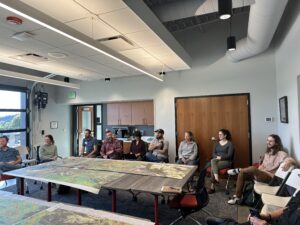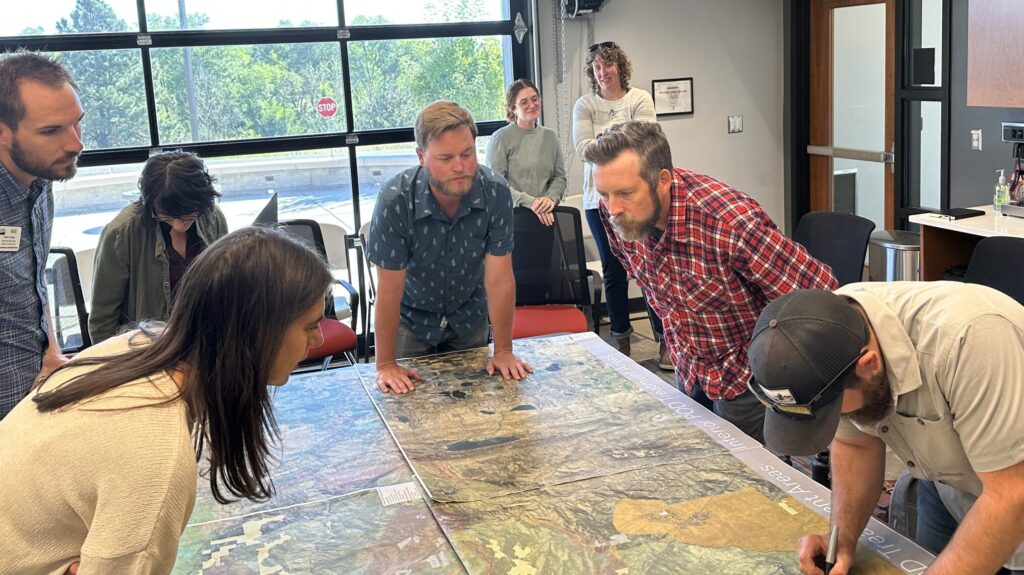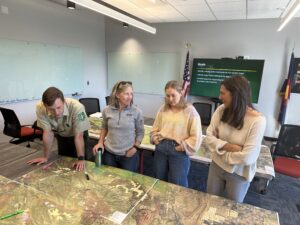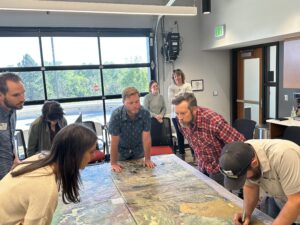In a recent gathering that underscored the importance of community collaboration in mitigating the risks of wildfires, the Big Thompson Watershed Health Partnership (BTWHP) once again convened to review and discuss Potential Operational Delineations (PODS) boundaries. These PODS serve as a vital framework for strategically managing wildfire risks and resources in this ecologically significant region.
Daniel Godwin, Fire Management Planning Specialist and Wildfire Crisis Strategy Program Manager with the Arapaho-Roosevelt National Forest began by presenting an overview of the comprehensive approach envisioned by the US Forest Service (USFS). The involvement of climate and fuels experts from Northern Colorado, including the Colorado Forest Restoration Institute (CFRI) at Colorado State University and other members of the Northern Colorado Fireshed Collaborative, will be instrumental in this process. Here’s a closer look at the key highlights and discussions from the meeting.
Arapaho-Roosevelt National Forest began by presenting an overview of the comprehensive approach envisioned by the US Forest Service (USFS). The involvement of climate and fuels experts from Northern Colorado, including the Colorado Forest Restoration Institute (CFRI) at Colorado State University and other members of the Northern Colorado Fireshed Collaborative, will be instrumental in this process. Here’s a closer look at the key highlights and discussions from the meeting.
Step-by-Step Process Envisioned by the USFS
- Collaboratively Plan: Emphasizing the importance of a united front in tackling wildfire challenges, collaborative planning forms the foundation of the process.
- Strengthen POD Boundaries: The meeting highlighted the need to fine-tune and strengthen POD boundaries to optimize resource allocation and response strategies.
- Burn within PODS: As a long-term goal, controlled burns within PODS are envisaged as a crucial tool in managing wildfire risks and promoting ecosystem health.
- WUI Treatments: “Wildland-Urban Interface” (WUI) treatments will be incorporated into the strategy to protect communities at the forest’s edge.
- Managed Fire: Controlled and managed fires are being explored as an integral part of the long-term strategy.
Diverse Treatment Approaches
To effectively address wildfire risks, the USFS plans to employ a range of treatment types. However, the ultimate aim is to utilize controlled burns, especially as a first-entry strategy. This approach aligns with Indigenous forest management principles that recognize the ecological benefits of fire.
Fireshed-Wide Strategy
The overarching goal is to establish a common delineation for the entire Fireshed, enabling stakeholders to articulate a unified strategy across the collaborative landscape. Importantly, this approach is grounded in a bottom-up, community-driven process that recognizes the unique needs and challenges of the region.
Partners participated in the workshop by gathering around maps created from a previous PODS workshop. This interactive session allowed for a detailed review and discussion of the proposed PODS boundaries by the USFS, based on the valuable feedback and suggestions from the partners.
Strategic Focus: Pole Hill/Waltonia POD
In a significant decision, partners collectively agreed to prioritize the Pole Hill/Waltonia POD for immediate attention. Given the multitude of projects occurring in this area, partners recognized the need to focus efforts where they could have the most substantial and immediate impact. The intention is to then work westward, addressing the areas of greatest risk to communities, with Estes Park being a primary consideration.
This most recent meeting of the BTWHP marked a significant milestone in the ongoing efforts to enhance fire management and resilience in the Big Thompson Watershed. Through collaborative planning, strengthened POD boundaries, and a commitment to incorporating controlled burns when possible, the vision of a Fireshed-wide strategy is taking shape. This collaborative approach demonstrates a strong commitment to the safety and ecological health of this vital region, and it underscores the importance of local stakeholders coming together to tackle the complex challenges posed by wildfires.


